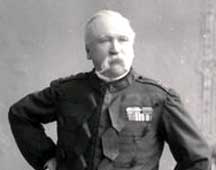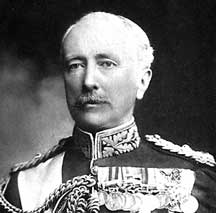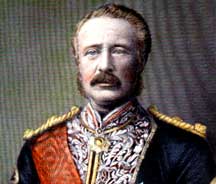|
|
|||||||
|
Sir Frederick Dobson Middleton, Sir Garnet Joseph Wolseley, General Charles Gordon |
|||||||
|
One thing leads to another |
|||||||
| White Rock B.C. - Wednesday, April 16, 2003 - by: Brian Marlatt | FTLComm - Tisdale - Wednesday, April 16, 2003 | ||||||
| I was once told that design of homes of the type illustrated
in your April15th edition derived from the arrival of 19th century British officers
who had served in India, usually Royal Engineers. I have lived in a
similar building or cottage in London, Ontario. |
Brian's story about the house from Admiral is really
important about the detail, because it was the odd details in this house that lead
to developing the story yesterday
about the depression. As I worked on restoring the image there were several things
about this house that made it clear that it was not a typical Saskatchewan farm house
of the twenties and thirties. The house did not have eve troughing, though it had pipes to handle the run off the roof, but instead of eve troughs that we are familiar with today, it had this curious board on the shingles with supports to hold it in place. The other architectural element that seemed odd to me was the buttresses used to support the overhang of the roof. The soffet area looks to have four foot studding and required these braces to hold it up. I do not recall seeing this feature on a house before. Brian mentioned the upper windows being primarily for ventilation and this seems to be accurate as the centre portion of the area appears to be a small door rather then a window. One interesting feature of this house is that it sits on what appears to be a concrete foundation and the water pipes from the roof seem to go to a basement cistern. . |
||||||
| As you face the cottage in the picture a formal living room is found on the right with an active living room beyond it and a kitchen behind it. A master bedroom is found on the the left and a smaller bedroom beyond it. A bathroom had been included in the student digs, previously faculty, I occupied. The upper window is shallow and mainly for ventilation. A pleasant veranda had been added....I don't know if it was original ... running from the front door to the picture right or east. | |||||||
| London is the original home of the Royal Canadian Regiment (RCRs). The RCRs served in the Crimea and, under Middleton, took part in the North West Rebellion. Wolseley commanded afterward. He was, of course, one of the most brilliant of British officers to serve in the later 19th century. He was sent, later, to Egypt where he defeated the colonels at Tel el Kiber, and was instructed, to arrive too late for political reasons, to relieve Gordon at Khartoum, ending his career. Gordon was, of course, a general officer of the Royal Engineers. | |||||||
| The idea that this house was of a British military design | |||||||
| makes perfect sense, although we as yet have not confirmed if the blacksmith who lived in the house built, or bought, the dwelling. But we will find out. The youngest of the three girls in the picture lives in Indian Head, while the eldest lives in Winnipeg. The next town to Indian Head is Qu' Appelle which had a fire that began at 3:00AM today and totally destroyed one of the oldest hotels in the province. The hotel was built in 1882 and was on the list of historical sites to be named this week and is famous for having once housed none other than Sir Frederick Dobson Middleton. | |||||||
| Brian Martall tells us a brief tidbit or two about the Royal Canadian Regiment, but we can not leave this story with a tidbit or two. It is just to easy to get the facts confused and so, let's take this last paragraph of his and check out some of the facts. | |||||||
 Sir Frederick Dobson Middleton is not exactly where the story begins, but it is the name mentioned first. Born in Belfast (Northern Ireland) and educated at the Royal Military College in Sandhurst, he was a career officer who had served around the world with considerable distinction including here in Canada in 1868 - 70. The short and simple biography in the University of Saskatchewan Library web site outlines his career and how he came to be in charge of the Midland Provision Battalion from Ontario to deal with the Northwest Rebellion of 1885. The field communications were not so good during the battle at Batoch much of Middleton's force did not hear the signal to attack so he decided to have lunch, Lt. Col. Williams in charge of the unit out of communications, figured the Metis were just about out of ammo and charged. Middleton was not amused and tried to have Williams court marshalled. Afterward he was set to stay on in Canada but a scandal occurred over some theft from the Metis and he went back to England where he lived out the rest of his career as the keeper of the Crown Jewels. |
|||||||
 Sir Garnet Joseph Wolseley is one of England's most distinguished soldiers of all time. He came to Canada in 1861 because the British government suspected that the Civil War might well lead to the American's invading Canada. As it turned out the Americans used a bunch of Irish terrorists to carry out their Canadian campaign and Garnet Wolseley was there to sort out the Fennan raids. Then in 1870 Louis Riel began the ill fated attempt at establishing the Republic of Manitoba, the "Red River Rebellion". It was Wolseley who was sent out West to arrange an end to that action. As Brian mentioned, the guy was everywhere in the Empire from Egypt to the Zulu rebellion, the Boer War and even influenced World War One. He was made head of the British arm for almost a decade and he planning and did contingency strategic work which still is used by the British to this day. The list of references at the bottom of the page have some amazing material about this outstanding man including a dispatch he wrote during his famous victory at Tel El Kebir. |
|||||||
 General Charles (Chinese) Gordon began his career with the Royal Engineers in 1852 and dashed around the British Empire distinguishing himself as an outstanding leader and impressive organiser. He had resigned from ill health but the British government needed someone who could act alone in difficult situations and sent their man back into action in the Sudan facing a 19th century fundamentalist Islamic fanatic, Muhammad Ahmad al-Mahdi. From February 1884 until January 26, 1885 he was under siege inventing land mines, using artillery and every trick he could think of, but was betrayed by an Egyptian and was shot dead in the street. Wolseley's force arrived two days later. Not only was this bad news for General Gordon, it cause the fall of the British Prime Minister of the day. |
|||||||
| As I mentioned earlier, the stories mentioned here by Brian Marlatt and the summaries I have presented, are really just teasers. These three men and the times in which they lived, and in Gordon's case, died, were remarkable and one need not be a scholar to find these people and what they were involved in, truly interesting. | |||||||
| References | |||||||
|
|
|||||||
|
|
|||||||
|
|
|||||||
